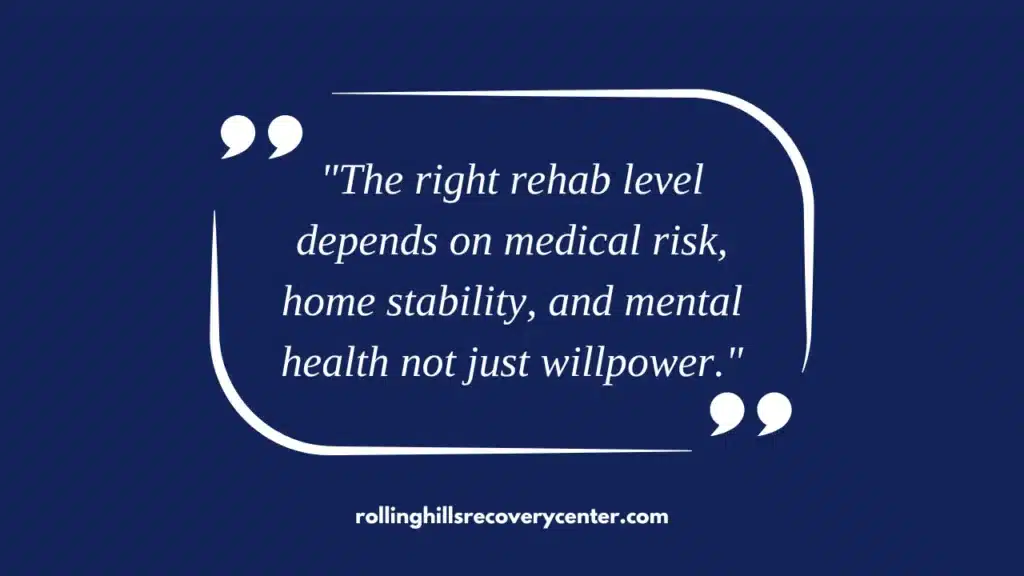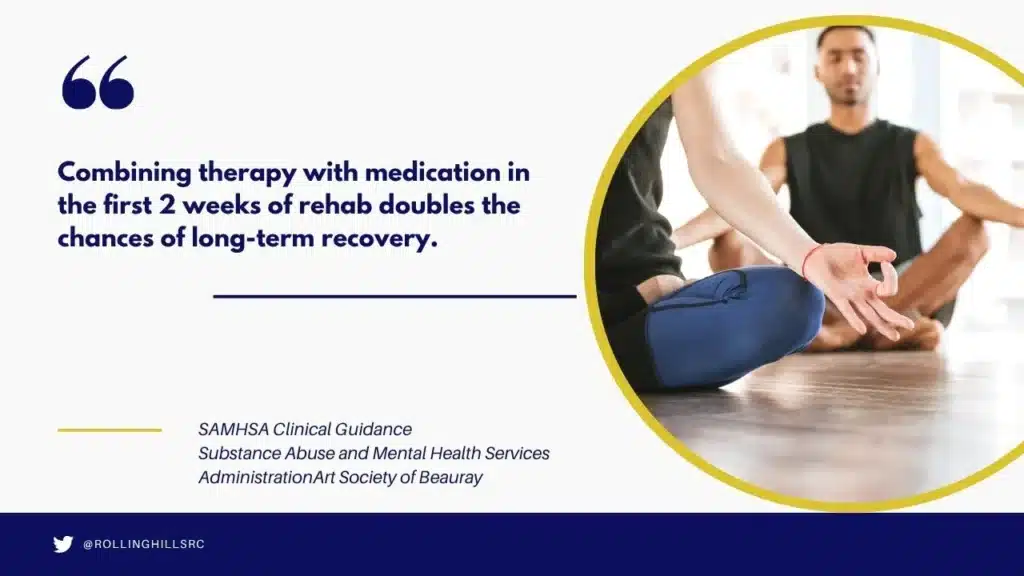Alcohol use disorder affects health, work, and family life, and it is treatable. This overview explains when rehab is needed, what safe detox looks like, and how New Jersey residents can match care to their needs. Expect clear steps, evidence‑based treatments & practical supports, from screening and medications to aftercare planning & local resources.
Key Takeaways
- Loss of control, cravings, rising tolerance, or withdrawal signal alcohol use disorder; seizures, delirium tremens, pregnancy, or heavy daily drinking require supervised detox, don’t stop suddenly at home.
- Level of care should match risk using ASAM criteria: medical detox, inpatient/residential, PHP, IOP, and standard outpatient; integrate care for co-occurring mental health needs.
- Proven care works: FDA-approved medications with CBT/MET and family therapy; begin relapse prevention early… and keep supports in place after discharge.
- Coverage and safety in NJ: most plans cover alcohol treatment under parity; verify benefits and any preauthorization, protect privacy with HIPAA & 42 CFR Part 2, job leave through FMLA or short-term disability when eligible.
Understanding Alcohol Use Disorder and When Rehab is Needed
Quick DSM-5 Clues You Can Use
Alcohol Use Disorder (AUD) is a medical diagnosis. In plain terms, it means alcohol has begun to control time, energy, and health. A quick read of DSM‑5 criteria points to common symptoms:
- Loss of control: drinking more or longer than planned; unsuccessful attempts to cut down
- Tolerance and withdrawal: needing more to feel the same (tolerance), or feeling shaky, sweaty, anxious, or nauseated when alcohol wears off (withdrawal)
- Life impact: alcohol causes problems at home or work; giving up activities; using in risky situations; craving
Two to three symptoms suggest mild AUD, four to five moderate, and six or more severe. If any withdrawal symptoms are present, a medical detox evaluation is recommended.
Safety Flags That Point to Medically Supervised Detox
Some alcohol withdrawal symptoms are mild. Others are dangerous. The following red flags mean detox should be medically supervised (inpatient or hospital-based):
- History of severe withdrawal, seizures, or delirium tremens
- Heavy daily drinking, especially with morning use to “steady” hands
- Co-occurring medical issues (e.g., heart, liver disease), pregnancy, or benzodiazepine use
- Inability to keep down fluids, confusion, hallucinations, or uncontrolled vomiting
- Living alone without a reliable support person
When in doubt, seek a same-day clinical assessment. In New Jersey, programs can coordinate rapid admission for high-risk cases.
Simple Screening Tools You Can Use Today
Two brief tools offer a fast snapshot:
- AUDIT‑C: a 3-question screen on frequency, quantity, and heavy-use episodes. Scores range 0–12; 4+ for men and 3+ for women often indicate risky drinking. It takes under a minute to complete and can guide next steps toward a fuller assessment.
- CIWA‑Ar: a 10-item scale clinicians use to grade withdrawal severity and adjust medication. It isn’t a DIY measure; however, knowing your team will use it helps you understand how dosing decisions are made and why monitoring is frequent early on.
Step-by-step if you’re unsure: Step 1: List the last 30 days of use and any withdrawal symptoms you’ve had. Step 2: Complete AUDIT‑C online or on paper. Save your score. Step 3: Call a licensed program and ask for a same-day evaluation. Note: If you’ve had a seizure or are vomiting, go to the ER.
New Jersey Context: DUI Risk, Workplace Leave, Privacy

New Jersey law treats impaired driving strictly. An arrest risks license suspension, fees, and mandatory education or treatment. Seeking care early can reduce risk and sometimes support court outcomes when documented appropriately.
Work leave and job protection are possible. Many NJ residents use:
- Federal FMLA (unpaid, job-protected leave for eligible employees)
- NJ Temporary Disability Insurance (TDI) for wage replacement when a licensed provider certifies a health condition, such as AUD
- Employer-provided Short-Term Disability or EAP services
Privacy is protected. HIPAA covers medical records, and 42 CFR Part 2 provides additional safeguards for substance use treatment records. You control consent for information sharing, with few exceptions (e.g., emergencies, mandated reporting).
Rolling Hills Recovery Center provides confidential evaluations, including for individuals worried about DUI risk or employment concerns, and can coordinate documentation for FMLA/TDI when appropriate.
Types of Rehab Centers and Levels of Care

Alcohol rehab is not one-size-fits-all. Levels of care are matched to clinical need, home stability, and motivation. The ASAM Criteria is the common framework used across New Jersey.
| Level of care | ASAM Level | Setting & intensity | Typical length | Best for |
|---|---|---|---|---|
| Medical Detox | 3.7‑WM (residential) or 4.0‑WM (inpatient/hospital) | 24/7 nursing, daily physician visits, CIWA‑Ar monitoring, meds for withdrawal | 3–7 days, sometimes longer | Moderate-to-severe withdrawal risk, medical complications |
| Inpatient/Residential | 3.5 or 3.1 | 24-hour structured living; daily groups and therapy; medical oversight | 2–4 weeks common; varies | High relapse risk, unstable home setting, co-occurring needs |
| Partial Hospitalization (PHP) | 2.5 | 5–6 hours/day, most weekdays; home at night | 2–4 weeks | Step-down from inpatient or higher support than IOP |
| Intensive Outpatient (IOP) | 2.1 | 9–12 hours/week of structured groups and therapy | 4–12 weeks | 1–3 hours/week, individual and group |
| Standard Outpatient (OP) | 1.0 | 1–3 hours/week individual and group | Ongoing | Stable recovery, continuing care, lower acuity |
| Medication-Assisted Treatment (MAT) | Varies (often 1.0) | Outpatient medical visits for alcohol medications; integrated therapy | Months to years | Anyone seeking relapse-prevention medication |
In New Jersey, many people start with detox, then step to residential, PHP, IOP, and finally OP. Others enter directly at IOP when withdrawal risk is low and home is stable.
Matching Needs To ASAM Levels: A Quick “How To”
Step 1: Determine withdrawal risk (CIWA‑Ar in clinic; consider past seizures, daily intake, and medical issues). Step 2: Evaluate relapse risk and environment (unsafe home, violence, or easy alcohol access may push intensity up). Step 3: Screen for co-occurring mental or physical conditions needing medical oversight. Step 4: Select the lowest safe level that meets needs, then step down as stability improves.
Length of Stay and Family Involvement
Length varies. Detox is short. Residential or PHP often run 2–4 weeks, but clinical needs drive time, not the calendar. Family engagement is a treatment multiplier. Programs may offer:
- Family education about AUD as a brain and behavior condition
- Boundary-setting and communication training
- Involvement in relapse prevention planning, with consent
Integrated Care for Co-Occurring Conditions
Anxiety, depression, PTSD, bipolar disorder, and trauma are common. Quality programs provide same-day or within-week psychiatric assessment, medication management when needed, and trauma-informed therapy. Integrated treatment reduces relapse risk and improves function.
Rolling Hills Recovery Center emphasizes evidence-based therapies and can coordinate psychiatric care for co-occurring disorders.
Evidence-Based Care & What to Expect

The Biopsychosocial Assessment
The first days focus on a whole-person evaluation:
- Medical: vitals, labs (including liver function, electrolytes), withdrawal monitoring, vitamin deficiency risk
- Psychological: history of mood, trauma, sleep, attention, suicidal thoughts
- Social: housing, family supports, transportation, legal challenges, occupational risks
- Substance history: patterns, attempts to cut down, periods of abstinence, consequences
This assessment guides the individualized plan, including level of care, therapy mix, medication, and safety planning.
Withdrawal Management: Safe, Steady, and Monitored
Benzodiazepines are first-line for moderate-to-severe alcohol withdrawal and are dosed using CIWA‑Ar protocols. For milder cases or as adjuncts, gabapentin, carbamazepine, or clonidine may be used, depending on clinical judgment.
Thiamine (vitamin B1) is routinely given to prevent Wernicke’s encephalopathy, along with folate and hydration. Only take these medications under medical supervision; dosing is individualized and needs monitoring.
For those with liver disease, medication choices may change. A physician will also screen for other substances, since combined withdrawal (e.g., benzodiazepines or opioids) alters the plan and safety approach.
Therapies That Work: Trauma‑Informed CBT and Motivational Approaches
Treatment pairs skill-building with motivation:
- Cognitive Behavioral Therapy (CBT): identify triggers, change thinking loops, rehearse new coping skills
- Motivational Enhancement Therapy (MET): build reasons for change, resolve ambivalence without shaming
- Trauma‑informed care: safety, choice, and empowerment front-and-center; no details are forced; pacing is respectful
- Relapse prevention: cue awareness, urge surfing, social rehearsal, and an actionable plan for slips
- Family therapy: reduce blame, build consistent communication, align expectations at home
Rolling Hills Recovery Center integrates these therapies with holistic supports such as mindfulness, exercise, and recovery-oriented nutrition to strengthen brain and body recovery.
FDA‑Approved Medications for Alcohol Use Disorder
Medication helps cravings and relapse risk, and can be used with therapy:
- Naltrexone (oral daily or monthly injectable): reduces rewarding effects and cravings; not for those on opioids; use caution with acute hepatitis or liver failure
- Acamprosate (oral, three times daily): helps maintain abstinence by stabilizing glutamate/GABA systems; dose-adjust in kidney disease; safe for those avoiding hepatic metabolism
- Disulfiram (oral daily): causes an aversive reaction when alcohol is consumed; best for highly motivated individuals with supervision; avoid if significant cardiovascular disease or severe liver disease
A clinician will help choose the right agent, start timing (often after detox), and follow labs as needed. Many NJ patients continue MAT during step-down and for months to years for stability.
What to Expect: Milestones in Weeks 1–4
- Week 1: medical stabilization; sleep and appetite begin normalizing; cravings may spike; begin CBT skills; establish a safety plan; vitamins started
- Week 2: clearer thinking; adjust therapy goals; involve family; select and start MAT if appropriate; address legal/work documents
- Week 3: deepen relapse prevention; practice refusal skills; rehearse high-risk scenarios; finalize aftercare plan; consider mutual-help meetings
- Week 4: step-down to IOP/OP; arrange therapy schedule; schedule medication follow-ups; confirm transportation and telehealth access; create a return-to-work plan
Health Foundations: Nutrition, Sleep, Peer Support
Alcohol depletes nutrients. Thiamine and folate are standard early on. Nutritional counseling focuses on protein intake, complex carbohydrates, hydration, and gentle refeeding to avoid GI distress.
Sleep takes time to recover; cognitive-behavioral strategies for insomnia, light exercise, and caffeine timing help.
Peer support, whether 12‑step (AA), SMART Recovery, or similar groups, adds structure and accountability without replacing clinical care.
Quality, Safety & Insurance
Accreditation, Licensure, and Staffing Signals
Look for accreditation by The Joint Commission or CARF, plus NJ licensure through the Division of Mental Health and Addiction Services (DMHAS). These indicate safety oversight and standardized policies. Ask about:
- 24/7 nursing in detox settings and daily medical provider availability
- Therapist qualifications (e.g., LCSW, LPC, LCADC) and average caseloads
- On-call physician coverage for nights/weekends during early recovery
Rolling Hills Recovery Center follows evidence-based protocols and employs experienced clinicians who specialize in alcohol and co‑occurring disorders.
Outcomes, Privacy, and Harm Reduction
Programs should measure outcomes: engagement, completion, reductions in alcohol use, improvements in function, and follow-up at 30/90 days. HIPAA and 42 CFR Part 2 protect privacy.
High-quality care also respects harm reduction: if abstinence is not immediately achievable, clinicians still work to reduce harm (e.g., safer-use education, MAT, medical monitoring) while keeping the door open to further change.
Insurance Parity, Verification of Benefits, and Leave Basics in NJ
Under federal parity law, many plans must cover addiction treatment at levels comparable to medical care. In New Jersey, Medicaid and commercial plans typically cover detox, residential, PHP/IOP, MAT, and psychotherapy when medically necessary.
How to verify benefits quickly: Step 1: Call the number on your insurance card (Behavioral Health or Member Services). Step 2: Ask: “What are my benefits for SUD treatment, detox, residential, PHP, IOP, OP, and MAT?” Step 3: Confirm in-network options, prior authorization needs, and copays/deductibles. Step 4: Request a reference number for your call. Save it.
Work leave basics:
- FMLA: up to 12 weeks of unpaid, job-protected leave if eligible; substance use treatment qualifies when provided by licensed providers
- NJ TDI: wage replacement during medically certified disability; your clinician supplies documentation
- Employers may also offer Short-Term Disability and EAP services for counseling and referrals
Rolling Hills Recovery Center’s admissions team can guide verification of benefits and provide documentation to support FMLA/TDI, when clinically appropriate. For a broader clinical overview by condition, read treatment for substance abuse in NJ.
Transportation and Telehealth Access in NJ
Transportation is often a barrier. Programs can help coordinate rideshares, NJ Transit accessible routes, or adjust schedules around commuting. Telehealth IOP or OP is used across the state for therapy and medication follow-ups when clinically appropriate. Patients in early withdrawal or with safety risks are generally seen in person.
Aftercare and Long‑Term Support in NJ

Step‑Down Planning: PHP → IOP → OP and MAT Continuation
Effective recovery plans start before discharge:
Step 1: Confirm the next level of care with dates, times, and location (PHP, then IOP, then OP). Step 2: If taking naltrexone, acamprosate, or disulfiram, schedule refills and monthly or quarterly medication checks. Step 3: Keep therapy frequency realistic: IOP 3–4 days/week, then OP weekly, tapering as stability grows. Step 4: Identify triggers and practice responses; rehearse real-life scenarios (work events, family stress, holidays).
A written plan reduces missed appointments and strengthens momentum. Patients can keep a one-page calendar with contacts and follow-ups in their wallet or phone. Rolling Hills Recovery Center coordinates these handoffs so individuals don’t have to navigate alone.
Mutual-Help Groups, Crisis Lines, and Peer Support
Mutual-help options in NJ include AA, SMART Recovery, and secular groups. Try several to find a good fit; meeting styles and cultures vary. For crisis or after-hours support, save these resources:
- 24/7 confidential help: SAMHSA National Helpline. Local hospitals and mobile crisis teams can also help during acute emergencies. Pairing peers (recovery coaches) with therapy and MAT improves retention.
Family Education and Involvement
Family involvement lowers relapse risk when done well. Educate loved ones about:
- What cravings feel like and how long they last
- Setting boundaries that are consistent and kind
- Avoiding “testing” and keeping alcohol out of the home during early recovery
- Signs of relapse and how to respond (see the Relapse Response Card below)
Family nights, therapy sessions, or education workshops are common. Many NJ employers also offer EAP sessions for family members.
Sober Housing Considerations in NJ
Sober living can bridge the gap between rehab and independent living. When evaluating homes:
- Confirm written house rules, curfew, house meeting schedules, and testing policies
- Ask whether MAT is allowed (it should be)
- Check for clear grievance procedures and transparent fees
- Visit in person if possible; look for cleanliness, safety, and a supportive culture
Your treatment team can help match the right location and structure to your needs and work or school schedule.
Return‑to‑Work Planning and a Practical Relapse Response
A structured return prevents overwhelm. Start with half-days if possible, with breaks timed to high‑risk periods. Share only what you choose; HIPAA and 42 CFR Part 2 protect your health information.
If a safety‑sensitive job is involved, medical clearance may be needed; your clinician can provide a fitness‑for‑duty letter without unnecessary details.
Relapse Response Card (print or keep on your phone):
- Early warning signs for me: sleep loss, isolating, skipping meetings, irritability
- 3 people I will text or call immediately: names and numbers
- What I will do in the first hour: leave the high‑risk situation, hydrate, eat, breathe for 3 minutes, call my support
- My next clinical step: attend a same‑day group, schedule an extra therapy session, or return to detox if safety demands
- If I drank: I will tell my clinician within 24 hours and restart my plan, no self‑blame, just action
The goal is not perfection. It’s a rapid, compassionate course correction and learning.
Key References to Ground Choices and How to Use Them
- Readable overview of treatment options and what’s evidence‑based: NIAAA treatment overview. How to use: compare your current or planned care with the NIAAA list of therapies and medications; bring mismatches to your team and ask why.
- Placement decisions and level‑of‑care matching: ASAM Criteria. How to use: ask your clinician which ASAM dimensions were considered (e.g., withdrawal risk, readiness to change, relapse potential) and why the recommended level fits you.
- CDC public health risks and data on alcohol: How to use: review risks tied to drinking patterns; this can clarify your goals (abstinence vs. reduction) and the intensity of care needed.
- Licensing and NJ resources: NJ DMHAS. How to use: confirm licensing status of any program you’re considering; explore state-funded options if uninsured.
- 24/7 support, referrals, and information: SAMHSA National Helpline. How to use: call anytime to get connected to local resources if you’re unsure where to start, or if financial barriers are in the way.
Rolling Hills Recovery Center in New Jersey offers evidence-based and holistic treatment for alcoholism and drug use, helping people move step-by-step through detox placement, inpatient or outpatient care, and into long-term support.
For confidential help choosing the right level of care or coordinating outpatient schedules near home, review this article on private alcohol rehab in NJ and outpatient alcohol rehab centers in NJ, or explore integrated treatment for substance abuse in NJ.
Conclusion
This article outlined when rehab is needed, how to choose care levels, and what evidence-based treatment looks like in NJ. Most important: match care to need, plan insurance and aftercare, keep MAT & therapy steady.
Frequently Asked Questions (FAQs)
What Signs Suggest It’s Time to Consider a Rehab Center for Alcohol Abuse in New Jersey?
When alcohol starts to control time, health, or safety, rehab centers for alcohol abuse should be considered. Red flags include drinking more than planned, failed attempts to cut back, cravings, rising tolerance, withdrawal symptoms (tremor, sweats, nausea, anxiety), and alcohol-related problems at work or home.
Medical risks such as a history of seizures or delirium tremens, daily heavy intake, pregnancy, or other chronic illnesses point to supervised detox rather than trying to stop alone.
In NJ, legal issues like DUI and workplace impairment policies also matter, so acting early reduces risk and improves outcomes.
How Should Someone Choose Between Inpatient and Outpatient Rehab Centers for Alcohol Abuse?
Match care to need. Inpatient rehab centers for alcohol abuse fit those with severe withdrawal risk, unstable housing, or co-occurring psychiatric conditions needing 24/7 structure.
Outpatient programs work when withdrawal risk is low, home is stable, transportation is reliable, and the person can manage triggers with support.
Clinicians often use ASAM level-of-care criteria, looking at intoxication/withdrawal, medical & psychiatric needs, readiness to change, relapse risk, and recovery supports. Insurance, job demands, and child care in NJ also shape decisions.
A brief medical evaluation plus a biopsychosocial assessment helps pick the safest, most effective path, sometimes stepping up or down as stability improves.
What Treatments Do Evidence-Based Rehab Centers for Alcohol Abuse Provide?
Effective rehab centers for alcohol abuse combine medical and behavioral care. Core elements include cognitive behavioral therapy, motivational enhancement, family involvement, and relapse-prevention skills.
FDA-approved medications, naltrexone (oral or extended-release), acamprosate, and disulfiram, reduce craving or support abstinence; they’re often continued through aftercare. Care plans usually add sleep support, nutrition, exercise, and mindfulness.
Peer recovery options (like 12‑step or SMART) can be layered in, not forced.
For co-occurring depression or anxiety, integrated psychiatric care is important. Expect regular progress checks, urine or breath testing when relevant, and an aftercare plan with short- & long-term goals.
What Do Rehab Centers for Alcohol Abuse Cost in NJ, and How Does Insurance Work?
Costs vary by level of care, length of stay, and benefits. Many rehab centers for alcohol abuse accept commercial insurance; plans often cover detox, inpatient, PHP/IOP, and medication management under mental health parity.
Verifying benefits confirms deductibles, co-pays, and any preauthorization requirements.
NJ FamilyCare (Medicaid) coverage depends on program eligibility. Patients may use FMLA or short‑term disability to protect job and income during treatment.
Privacy is protected by HIPAA & 42 CFR Part 2—releases are required before sharing information.
Keep all paperwork, request itemized bills, and appeal denials when clinically appropriate; documentation from the treating physician helps.
How Does Rolling Hills Recovery Center Stand Out Among Other Rehab Centers for Alcohol Abuse in New Jersey?
Care is individualized after a thorough psychosocial assessment; treatment may include detox coordination, medications for alcohol use disorder, structured therapy, family involvement, and practical relapse-prevention.
Attention to co-occurring mental health conditions, along with recovery coaching, supports durable change. Outcomes are monitored, privacy is respected, and transitions to aftercare are planned early, small details that, together, improve safety and success.
Author
-
Our editorial team includes licensed clinicians and board-certified addiction specialists. Every article is written and reviewed to be clear, accurate, and rooted in real treatment experience.
View all posts -
Dr. Williams has held senior leadership positions in the behavioral health field for over 30 years. He has worked with diverse populations in various private and public sectors.
View all posts












